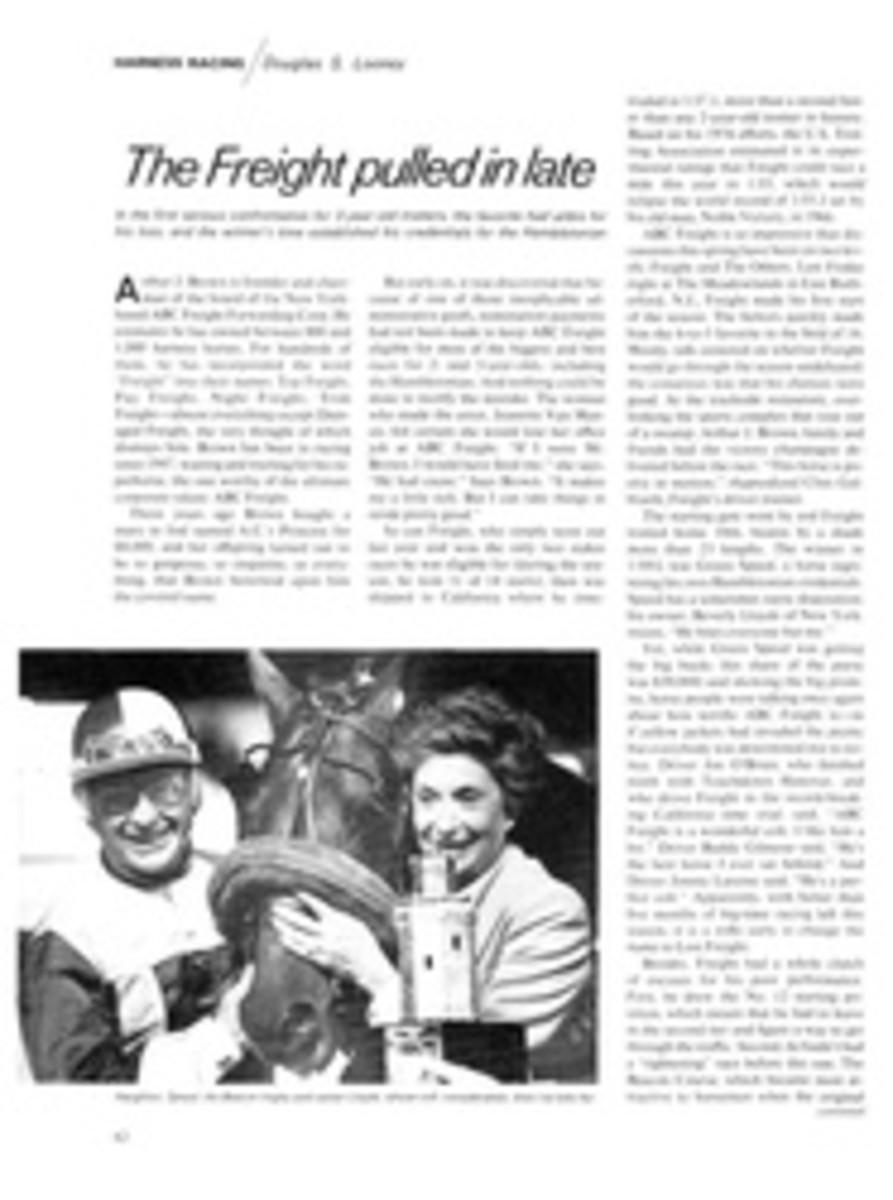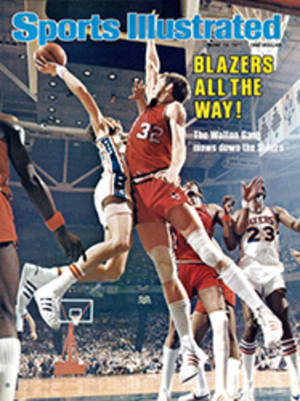
It's easy come, easy go
The former rightfielder for the New York Mets switched the telephone receiver to his other ear to make sure he had heard the money figures correctly. Obviously surprised when the same numbers were repeated to him, he said, "If you were Norm Cash or Jim Northrup, a talented major league baseball player in your day, and somebody offered you—how much did you say they're making, $30,000 apiece?—that much money just to play a little softball on weekends this summer, wouldn't you do it?"
The stunned man on the phone was Ron Swoboda, who is best remembered for the nose-dive catch he made in the 1969 World Series. Swoboda was understandably shocked to learn that Cash and Northrup, a couple of ex-Tiger heroes, are being paid so much by Mike Hitch, Motown's deep-dish pizza magnate, to come out of retirement and attract crowds for his Caesars, Detroit's entry in the new 12-city, first-of-its-kind, high-class, no-beer-in-the-dugout American Professional Slo-Pitch League. Swoboda, after all, has been offered a piddling $8,700 to play for the APSPL's New York Clippers—which is chicken feed for a man now employed as a sportscaster for CBS. The Clippers sweetened the package by throwing in a tiny percentage of the gate receipts, but because Swoboda assumes that those receipts will be small in the league's first season, he has not yet signed.
Sooner or later it had to come to this—a pro softball circuit, complete with fat contracts and holdouts just like the major leagues. Apparently it was only a matter of time until big spenders interested in owning sports franchises looked past the tombstones of the AFL and WFL, the ABL and ABA, the NLL and ITA and discovered slow-pitch softball, a game with untapped earning potential that is played by 35 million people in the U.S.
The APSPL's founding fathers were well aware of these figures when they decided to incorporate after nearly two years of market research. And they are not blind to the financial rigors ahead of them. President Bill Byrne, 40, is already a two-time loser, having served as director of player personnel for both the Chicago and Shreveport franchises in the now-defunct World Football League. Yet Byrne shelled out at least $27,000 of his own money to demonstrate to other investors his faith that America will like his latest endeavor.
Cash and Northrup do, for obvious reasons. Each makes a good living these days selling parts to the auto industry in Detroit. But neither could turn down $30,000 for playing a loose approximation of what made them famous in the first place. Besides, when people see their names in the paper again, it will certainly be good for business.
By signing with Hitch, himself an unlucky owner of the ill-fated WFL Detroit Wheels, Cash and Northrup gave some credibility to the new league. Other former major-leaguers of varying reputations have also joined up. Zoilo Versalles, the American League's Most Valuable Player with the Minnesota Twins in 1965, now plays shortstop for the Minnesota Goofy's, a team named after a popular Minneapolis bar. Milt Pappas, who won 209 big league games and pitched a no-hitter for the Cubs in 1972, manages Chicago; Gene Hiser, a utility outfielder during his five seasons as a major-leaguer, plays for Chicago. Danny Napoleon, a teammate of Swoboda's on the Mets, is with the New Jersey Statesmen, who play in Trenton. Other cities in the league are Baltimore, Pittsburgh, Cincinnati, Cleveland, Louisville, Milwaukee and Columbus, Ohio.
Slow pitch, it should be noted, is not the same game that America's most famous softballer, Eddie Feigner, plays. His game is fast pitch, in which the ball is only a blur between the mound and home plate. The result is usually a steady stream of strikeouts, little scoring and a minimum of excitement. By comparison, slow pitch is a home-run derby. The 12-inch ball may be delivered at only "moderate speed," and most of the former amateur players who have joined the APSPL can reach the league's 300-foot fences several times a game. In fact, sluggers Ronnie Ford and Bert Smith of the Caesars and Benny Holt of the Storm hit so many home runs during the first weekend of play that the league office became concerned that Chicago spectators might view the sport as some sort of freak show and never come back.
While most opening-weekend games in other cities had scores in the 10-8 range, Detroit won its inaugural over Chicago 28-21. The Storm then gained a split of the first-day doubleheader 27-25. Cash hit a home run the next day, but it was practically forgotten in the face of what his less famous teammates did to Chicago pitching. In the first game of another doubleheader Smith blasted four homers in four at bats to lead the Caesars to a 31-17 win. In the finale of the series Ford socked four and knocked in nine runs as Detroit won 46-24. Cash's blow was merely one of 16 Detroit home runs in that game, and during the weekend the two teams hit a total of 84.
By the end of the weekend Ford had league-high totals of 15 hits, nine homers and 20 RBIs, while Smith went 8 for 11 with six home runs and 12 RBIs. Chicago's Holt also had nine homers. The first-day attendance of 2,100 was encouraging—and right around the league average—but only 600 turned out to see the second-day slugfest.
Cash, now 42 and a good deal heavier than he was in 1961 when he led the American League with a .361 batting average, did not embarrass himself. He was 5 for 9 and timed a looping knuckler perfectly for his home run. "I knew it was gone the minute it left the bat," he dead-panned, after being fined $500—probably for publicity reasons—for missing the team's press day earlier in the week. Northrup had all his money, but was missing some of his pride. Had it not been for a bloop double, he would have ended up 0 for 11. Versalles and the rest of the major league contingent experienced similar difficulties.
"No problem," said Cash, assessing his debut. "I could become the Babe Ruth of Softball."
No doubt the ultra-efficient league office in Columbus quickly wired Stormin' Norman that such loose talk from a Johnny-come-lately like himself is not in the best interests of the American Professional Slo-Pitch League, seeing as how there already is a Babe Ruth of Softball.
Jim Galloway is his name. He stands 6'4", weighs 230 pounds and was so prodigious a slugger during his prime that he is just now, at age 42, dropping back into other people's range. A native of West Virginia who moved to Brooklyn in 1957 after graduating from Bluefield State College, Galloway has made the All-America slow-pitch team a record eight times as an amateur—twice as often as his closest competitor, Smith. And two of Galloway's home runs, out of a career total of more than 2,000, are the closest thing to legend that slow pitch has to offer.
A decade ago, when his County Sports team from Levittown, N.Y. won the national amateur championship, Galloway smashed a ball to dead center field that struck the top of a 40-foot flagpole 280 feet away. It was estimated that, had the ball not hit the pole, it would have carried 430 feet. Three years later Galloway poked another homer in the national tournament that was stepped off at 400 feet.
"That was a long time ago," says Galloway, who signed with the New York Clippers for $100 per game—or five times the average Clipper's salary. "I found out one thing in our first four games," he adds. "Three hundred feet is a very enticing target. But when you're hitting a slow-pitched Softball and providing all the power yourself, there are going to be a lot of 290-foot outs in this league. I had three homers on our first weekend, but if the fences had been 10 feet closer, I would have had 10."
Despite his reputation in Softball, Galloway is little known in the rest of the sports world. And this is Byrne's biggest problem: how to entice new audiences to take a look at established softball stars like Pittsburgh's 6'7", 290-pound Tom (Big) Miller or Cleveland's Buddy Bell-look-alike, Rich Petrunyak.
Probably the most impressive things about the new league are the big league-style travel (the teams fly nearly everywhere) and the first-class accommodations (in Minneapolis, for example, teams stay at the Leamington Hotel, as most American League clubs have for years). More important, the $25,000 for each franchise was paid up front, and all funds for hotels and plane fares have been put safely in escrow. So has the $100,000 pot that will be divided among the four teams that make it to September's APSPL World Series.
And there are some nice touches for the fans. The Milwaukee Copper Hearths' road games are being televised back home, and most teams will operate for at least part of this summer with open rosters. That means anybody who thinks he (or, presumably, she) could be the next Jim Galloway can drop by after work and try out. Brian Hewitt dropped by while he was at work. A sportswriter for the Chicago Daily News, Hewitt went out to do a story on the Storm and ended up making the team as a pitcher. He threw six innings of relief against the Detroit Caesars, yielding 14 runs, but still got the win in the 27-25 game.
Swoboda heard most of this on the phone the other day but was still skeptical. "If there's enough money and prestige behind something, there is no such thing as a bad idea," he said. "But, let's face it, anybody that wants to see slow-pitch softball can walk out to Central Park or any other field in the country and watch it to their heart's content. When I think of softball, I see a six-pack waiting for me at first base and another when I get to second. It's the image of the sport that may turn this league into a sham. I'm not convinced people will pay to see the game."
Perhaps—but fewer homers by the Detroit Caesars and more by Jim Galloway would certainly help.
PHOTO
Jim Galloway, the Babe Ruth of slow pitch, has had more than 2,000 homers in his 20 seasons.

